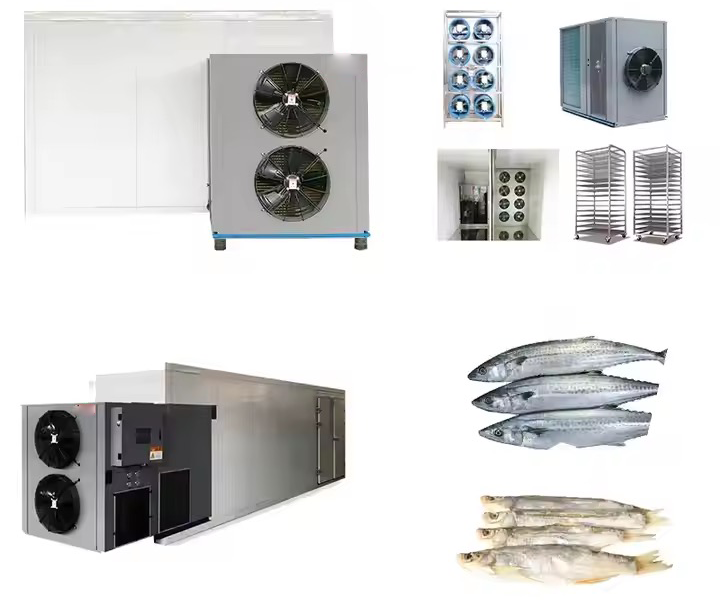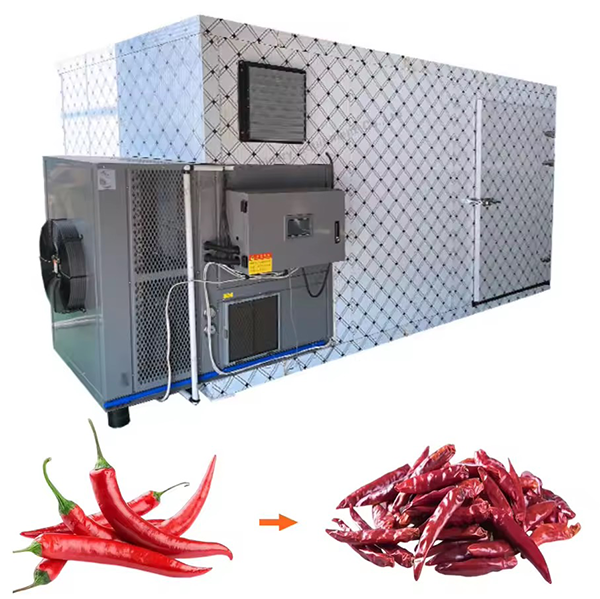
Content Menu
● Understanding Heat Pump Technology
● Key Features of Heat Pump Food Dehydrators
● Components of a Heat Pump Food Dehydrator
● Benefits of Using Heat Pump Technology in Food Dehydration
● Applications in Food Industry
● The Process of Using a Heat Pump Dehydrator
● Challenges and Considerations
● Future Trends in Food Dehydration Technology
● Conclusion
● FAQ
>> 1. What is a heat pump food dehydrator?
>> 2. How does a heat pump dryer work?
>> 3. What are the advantages of using a heat pump for food dehydration?
>> 4. Can I use a heat pump dehydrator for all types of food?
>> 5. Are there any maintenance requirements for heat pump dehydrators?
● Citations:
In the realm of food preservation, heat pump technology has emerged as a revolutionary method for drying various food products. This article delves into the key features of food dehydrators utilizing condenser dryers with heat pump technology, highlighting their efficiency, environmental benefits, and the superior quality of dried products they produce.

Understanding Heat Pump Technology
Heat pump technology operates on the principle of transferring heat from one location to another, using a refrigeration cycle. Unlike traditional drying methods that generate heat through combustion or electrical resistance, heat pumps extract ambient heat from the air and use it to dry food at lower temperatures. This process not only conserves energy but also maintains the integrity and nutritional value of the food.
Key Features of Heat Pump Food Dehydrators
- Energy Efficiency: One of the most significant advantages of heat pump food dehydrators is their energy efficiency. They typically consume 30-75% less energy compared to conventional dryers. This is achieved by recycling warm air within a closed-loop system, minimizing heat loss and reducing operational costs.
- Precise Temperature Control: Heat pump technology allows for precise control over temperature and humidity levels within the drying chamber. This precision ensures that food is dried uniformly without the risk of overheating, which can degrade quality and nutritional content.
- Gentle Drying Process: The ability to operate at lower temperatures (typically between 30°C to 80°C) means that delicate foods such as fruits, vegetables, and herbs can be dried without losing their color, flavor, or nutrients. This gentle drying process is crucial for preserving the quality of high-value products.
- Reduced Drying Time: With efficient air circulation and heat recovery systems, heat pump dehydrators can significantly reduce drying times. The rapid moisture removal helps in maintaining product quality while enhancing productivity.
- Environmentally Friendly: Heat pump dryers are eco-friendly as they do not emit harmful gases or pollutants. Their energy-efficient operation reduces reliance on fossil fuels, contributing to a lower carbon footprint.
- Versatile Applications: These dehydrators can handle a wide variety of foods including fruits, vegetables, meats, and herbs. This versatility makes them suitable for both commercial and home use.
Components of a Heat Pump Food Dehydrator
A typical heat pump food dehydrator consists of several key components:
- Compressor: Compresses refrigerant gas to increase its temperature and pressure.
- Evaporator: Absorbs heat from the ambient air and evaporates the refrigerant.
- Condenser: Releases absorbed heat back into the drying chamber while condensing the refrigerant back into liquid form.
- Expansion Valve: Regulates the flow of refrigerant into the evaporator.
- Air Circulation System: Ensures even distribution of hot air throughout the drying chamber.
These components work together to create an efficient drying environment that optimizes energy use while maintaining product quality.
Benefits of Using Heat Pump Technology in Food Dehydration
1. Nutrient Retention: By operating at lower temperatures, heat pump dryers help retain vitamins and minerals in food products that might otherwise be lost during traditional drying processes.
2. Longer Shelf Life: Properly dehydrated foods have extended shelf lives due to reduced moisture content, which inhibits microbial growth.
3. Cost Savings: Although initial investments in heat pump technology may be higher than traditional methods, long-term savings on energy bills make them a cost-effective choice for businesses and consumers alike.
4. Consistent Quality: The precise control over drying conditions ensures that each batch of food maintains consistent quality in terms of taste, texture, and appearance.
5. Flexibility in Operation: Heat pump dryers can operate effectively in various ambient conditions, making them suitable for year-round use regardless of external weather conditions.

Applications in Food Industry
Heat pump technology has found extensive applications across various sectors within the food industry:
- Fruit Drying: Fruits such as apples, bananas, and berries benefit immensely from heat pump dehydration. The low-temperature process preserves their natural sweetness and vibrant colors while preventing enzymatic browning.
- Vegetable Drying: Vegetables like carrots, peppers, and tomatoes can be dried effectively without losing their crunchiness or nutritional value. This method is particularly advantageous for producing vegetable chips or powders used in soups and sauces.
- Herb Dehydration: Fresh herbs retain their essential oils and flavors when dried using heat pump technology. This makes it ideal for culinary applications where flavor intensity is crucial.
- Meat Drying: For jerky production or other meat preservation methods, heat pump dehydrators provide a controlled environment that minimizes bacterial growth while ensuring even drying.
The Process of Using a Heat Pump Dehydrator
Using a heat pump dehydrator involves several steps:
1. Preparation: Start by selecting fresh produce. Wash and cut fruits or vegetables into uniform pieces to ensure even drying.
2. Loading: Arrange the prepared food items on trays within the dehydrator. Avoid overcrowding to allow adequate airflow around each piece.
3. Setting Parameters: Adjust temperature and humidity settings according to the type of food being dried. Most machines come with preset programs for different foods.
4. Monitoring Progress: Periodically check on the dehydration process. Most modern dehydrators have built-in timers and indicators that alert you when drying is complete.
5. Storage: Once dried, allow the food to cool before storing it in airtight containers to prevent moisture reabsorption.
Challenges and Considerations
While heat pump technology offers numerous benefits, there are some challenges to consider:
- Initial Cost: The upfront investment for a high-quality heat pump dehydrator can be higher than traditional models; however, this cost is often offset by long-term savings on energy bills.
- Learning Curve: Users may need time to familiarize themselves with optimal settings for different types of foods to achieve desired results consistently.
- Maintenance Requirements: Regular maintenance is essential to ensure optimal performance; this includes cleaning filters and checking components periodically.
Future Trends in Food Dehydration Technology
The future of food dehydration technology looks promising with ongoing advancements:
- Smart Technology Integration: Many manufacturers are incorporating smart technology into their dehydrators, allowing users to monitor and control processes remotely via smartphone apps.
- Sustainability Focus: As sustainability becomes increasingly important in manufacturing processes, more companies are focusing on developing eco-friendly materials and designs for their machines.
- Research on Nutritional Preservation: Ongoing research aims to further understand how different drying techniques impact nutrient retention in various foods, leading to improved methods tailored for specific products.
Conclusion
Heat pump technology represents a significant advancement in food dehydration methods. By leveraging energy-efficient principles and providing precise control over drying conditions, these systems not only enhance product quality but also contribute to sustainability efforts within the food industry. As consumers increasingly seek healthier options and environmentally friendly practices, heat pump food dehydrators are poised to become a standard in both commercial and home kitchens.

FAQ
1. What is a heat pump food dehydrator?
A heat pump food dehydrator is an appliance that uses heat pump technology to remove moisture from food at low temperatures while preserving its nutritional value.
2. How does a heat pump dryer work?
A heat pump dryer works by extracting ambient heat from the air using a refrigeration cycle, then circulating this heated air within a closed chamber to dry food efficiently.
3. What are the advantages of using a heat pump for food dehydration?
The advantages include energy efficiency, precise temperature control, nutrient retention, reduced drying time, longer shelf life for products, and environmental benefits.
4. Can I use a heat pump dehydrator for all types of food?
Yes, heat pump dehydrators are versatile and can be used for various foods including fruits, vegetables, meats, herbs, and more.
5. Are there any maintenance requirements for heat pump dehydrators?
Regular maintenance includes cleaning filters and checking components to ensure optimal performance and longevity of the machine.
Citations:
[1] https://www.ike.cn/aio-df1500gw-heat-pump-food-dehydrator-for-fruit-and-vegetable
[2] https://vn.dryers-dehydrators.com/info/advantage-of-food-heat-pump-dryer-81163580.html
[3] https://pmc.ncbi.nlm.nih.gov/articles/PMC3550864/
[4] https://www.youtube.com/watch?v=gOoAke5T7PA
[5] https://www.youtube.com/watch?v=b153rzOB80s
[6] https://www.gelgoogdryer.com/machine/heat-pump-dehydrator.html
[7] https://www.dryeratech.com/what-s-the-benefit-of-using-a-heat-pump-dryer.html
[8] https://pmc.ncbi.nlm.nih.gov/articles/PMC4745420/
[9] https://www.youtube.com/watch?v=Xve5ZESFGME











